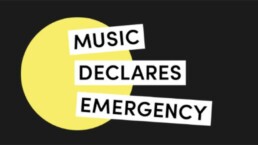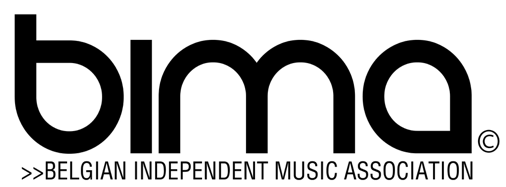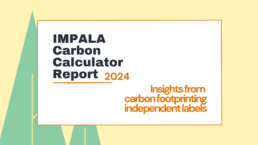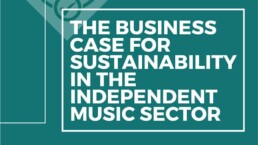Music Declare Emergency

This June 10th, Independent trade associations, A2IM (USA) and IMPALA (Europe) in partnership with Julie’s Bicycle are launching a free one-year pilot project of IMPALA’s Carbon Calculator in the USA with the support of Merlin. Occasion to remind you about « Music Declares Emergency » mouvement & encourage you to act now.
Music Declares Emergency is a group of artists, music industry professionals and organisations that stand together to declare a climate and ecological emergency and call for an immediate governmental response to protect all life on Earth.
We believe in the power of music to promote the cultural change needed to create a better future.
BIMA is already member of MDE…join the mouvement.
10 STEPS TO MAKE YOUR RECORD LABEL MORE SUSTAINABLE
1. Prioritise Sustainability
Make environmental sustainability a priority in your
business, nominate someone on your team who is
responsible for greening your activity. Put in place an
environmental policy and action plan with a net zero
target (e.g. by becoming carbon neutral by 2026).
Make opportunities for members of your teams to
get involved.
2. Green Your Pension
Switch pension scheme to one that does not invest in
fossil fuels. This is probably the most effective thing
you can do to act on the climate emergency, see Make
My Money Matter for more info. In the UK, Nest, Royal
London have schemes that don’t invest in fossil fuel
companies. Always check with your financial advisor.
3. Banking
Switch your banking to a bank that doesn’t invest in
fossil fuels see: switchit.green. If you can’t switch
(e.g., these more ethical banks don’t offer international
currency accounts yet), then ask your bank and pension
supplier for their sustainability policy and ask them to
divest from fossil fuels – every little bit of lobbying
helps! Switch funds on deposit to a greener bank. Make
My Money Matter have an open letter to send to the
worst offenders.
4. Energy
Switch to a renewable energy supplier or ask your
landlord to switch. Find out if your suppliers are
sourcing renewable energy – supplier rating here
switchit.green. Get an energy efficiency assessment
carried out on your building. Explore the potential to
install solar panels on your office and/or home. Install
a battery to make best use of the electricity generated.
Replace gas boiler with air source heat pump and
mechanical ventilation system. You’ll need to get an
energy assessment carried out on your premises by
a professional.
5. Communications
Set up a green team who can focus on key areas and
motivate each other. Use your social media platforms to
raise awareness of the climate crisis and related issues.
6. Campaigning
Get involved in campaigning organisation and/or local
environmental groups e.g. AIM Climate Action Group,
Music Declares Emergency, Climate action network
groups, Extinction Rebellion, Fridays for Future,
Greenpeace, Friends of the Earth
7. Carbon accounting
This allows you to record the carbon footprint of your
operations to create a baseline from which to reduce
your emissions, and getting a clear understanding of
where your largest impacts are in order to make the
most effective reductions.
Carbon Accounting Tools:
• Julie’s Bicycle have launched a record label specific
tool as part of the IMPALA sustainability programme.
Sign up here. For more information contact
krogozar@impalamusic.org
• Julie’s Bicycle Creative Green Tools
• Greenhouse Gas Protocol’s tool
8. Travel
Track your business travel and calculate the carbon
emissions using ecolibrium.earth. Use public transport
or electric hire cars, bike or foot where possible. Avoid
purchasing new vehicles, particularly those that run on
fossil fuels (the manufacture of new vehicles creates
significant footprint whether electric or otherwise).
Reduce or eliminate air travel where possible – use
video conferencing. Sign up to the Cycle To Work
Scheme and offer staff tax breaks to buy a bike. Offer
staff extra holiday to give them the time to take trains
instead of flying for their holidays:sign up to Climate
Perks and encourage others in the industry to do the
same.
9. Freighting Vinyl and CDs
Careful planning can help minimise any unnecessary
transport e.g., shipping direct to distributors from
pressing plants rather than via a distribution centre.
Use sea freight rather than air freight to ship to the USA,
it takes 3-4 weeks longer but is much cheaper and
much lower footprint e.g. sea-freight shipping agents
Woodland, Davies Turner
10. Digital footprint
For servers or server space you use for your own
websites – switch to servers that use 100% renewable
electricity. IMPALA are talking to the main digital service
providers about their sustainability policies. There is a
huge grey area around the footprint of digital servers,
see this article by our web developer Spork on the topic.
SUSTAINABLE RECORD MANUFACTURING 101:
Manufacturing
Ask your pressing plant (and other suppliers) for their sustainability policy, in particular:
• Are they compliant with ISO14001 (internationally
agreed environmental management system)?
Also ISO50001 (certified energy management
system) and ISO9001 (quality management)
accreditation?
• What power supply do they use (electricity, gas),
do they use renewable energy? Nuclear?
• Do they have waste reduction and recycling targets
in place? For example, see Optimal’s policy and
disclosures by scanning the QR code.
CDs & vinyl
The most important thing is not to press too many
copies, overstocks are expensive to make, transport,
store and recycle – and of course all this creates an
environmental footprint. Keep talking to your
distribution network to make the best assessment
of quantities required.
Local pressings
If possible manufacture in EU and USA to minimise
transport footprint. If manufacturing in Europe
(including UK) the EU’s REACH regulation ensures that
the pressings are made from a less toxic PVC. When
speaking to manufacturers in USA check if they are
pressing in the USA or in Europe – many manufacturing
brokers in the USA use pressing plants in Europe and
then air freight to USA. Also ask USA pressing plants for
the provenance of the vinyl raw material they are using.
Material choice
Use less material where possible – a 140gram vinyl has a
proportionally lower carbon footprint than 180gram with
regard to manufacturing and shipping, and no loss in
audio quality.
Recycled vinyl
100% recycled vinyl pressings with sound quality
comparable to non-recycled coloured vinyl are now
available at some plants, and most plants can press
on partially recycled vinyl. Generally this is the plant
recycling their own offcuts and waste. They can be
produced in black, other specific colours are possible
depending on availability, or a mix of colours with every
copy being different/unique which can be a selling
point. Research is currently ongoing into using
post-consumer plastic waste for audio pressings.
CD jewel cases
(which are made from polystyrene) have a high footprint
to manufacture and are not easily recyclable. Card
sleeves have 95% lower carbon footprint, and they
can look beautiful!
Record sleeves
Should be printed on recycled card or if not certified
by Forest Stewardship Council or Programme for the
Endorsement of Forest Certification (PEFC) (FSC and
PEFC certification ensures that the wood is sourced
from sustainably managed forests.)
Avoid mixing materials or using additional processes,
which makes it difficult or impossible to recycle sleeves
and packaging (including the waste left over from
manufacture) for example:
• Use vegetable-based inks and water-based
varnishes
• Avoid UV varnishes, laminates or foil finishes
• Avoid CD digipacks consisting of card outer and
plastic tray
• Use card fitments to keep box-set contents in
place rather than foam fitments
Shrink-wrap
Footprint is small and using it can reduce returns and
resulting additional manufacture & transport footprint,
so it’s not clear that it is always best to avoid shrink-wrap.
• Consider alternatives such as a more durable PVC
dust cover or paper belly band (banderole)
• Or a peelable sticker to seal the sleeve with text e.g:
“This record has not been shrink-wrapped to better
protect the planet. Please don’t return this record
if the sleeve has sustained some damage in transit.
The records inside should be perfect!”
• Compostable wraps/envelopes are now available,
but check with supplier on their toxicity when
biodegrading, and the conditions required to
biodegrade. These will require the consumer
to dispose of them appropriately so they should
be labelled accordingly.
Mail order
• Ensure packaging materials for mail order are made
from recycled card or FSC / PEFC sourced card, not
a mix of plastic and card.
• Use paper sticking tape rather than plastic.
• Offer discounts to mail order customers to retain
records which sustain damage to the sleeves in
transit. (Another part of stopping the culture of
returning records if there is a small dink on sleeve.)
MUSIC INDUSTRY CLIMATE PACK
202114
Merchandise
Ask your supplier for their ethical & environmental
policy – these suppliers have been recommended:
Rapanui, No Sweat, Teemill (See our merch section)
Offsetting record manufacture
The footprint of each CD or vinyl record manufactured
depends on the specification of each product, and the
amount of carbon offset by each scheme varies
depending on the success and management of each
project. In addition, you may want to build in a cost of
repairing climate damage as well as only offsetting the
carbon produced, so the process is complex. But in order
to simplify the process and prevent accurate carbon and
environment accounting delaying action, we recommend
using these amounts as a rough but fairly generous
guide to the amount you should invest for offsetting
(note these prices are kept in GBP as that is the original
currency of the calculation):
• 140gram LP/12” disc + sleeve = £0.13 (twice for a 2LP
etc)
• 180gram LP/12” disc + sleeve = £0.17 (twice for a 2LP
etc)
• CD + card sleeve = £0.05 (twice for a 2CD etc)
• 7” vinyl and sleeve = £0.05
• Allow additional amounts for bulky packages
Calculate the number of pressings you have made
and the offset price required for the total number of
units manufactured, then choose projects(s) from
Gold Standard website and make donations
accordingly.



